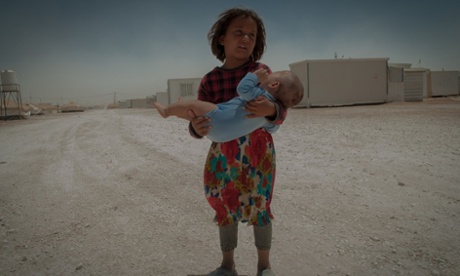This week marks three years since the start of the Syrian civil war. The conflict, which shows no sign of abating, has claimed 140,000 lives, forced 2.5 million people to flee for safety, and left a further 4.3 million people displaced within Syria’s borders. The UN estimates that 9.3 million people are currently in need of humanitarian assistance.
Agencies have issued multiple warnings and calls for help to deal with the conflict’s fallout. Only this week, Unicef and World Vision warned that – with millions of children facing collapsing health and education services, and suffering acute psychological distress and impoverishment – a potential “lost generation” is emerging.
There are also concerns about the pressure refugees are putting on neighbouring countries Jordan, Turkey and Lebanon. UN officials have repeatedly called for Europe to relax its border controls in order to ease the growing humanitarian crisis on its doorstep, and have issued multiple appeals for financial assistance.
The public has become accustomed to images from Syria and beyond being beamed around the world, and has responded sympathetically. Thousands joined solidarity vigils for the #withsyria campaign, for which Banksy adapted an iconic image currently doing the rounds on social media. But what is it really like to be on the frontline of the humanitarian response?
We’ve been using GuardianWitness to document the crisis since last April, covering everything from tea sellers in Zaatari camp to life in a transit base inside Syria. Your stories have helped us understand day-to-day life for refugees. Here we catch up with some of our key contributors as they reflect on a troubled three years in the region.
Three years ago, would you ever have imagined the Syria refugee crisis would grow to its current size and magnitude?
I’m sorry to answer yes to this question. I’ve lived and worked in the Middle East for more than 20 years and have been to Syria many times. I am familiar with the nature of these regimes when it comes to threats to their power. – Steve Sosebee, Palestine Children’s Relief Fund (PCRF)
From the perspective of the UN’s Palestinian refugee agency, never, never, never. Yarmouk was once the thriving, bustling heart of the Palestinian community in Syria, where they lived alongside Syrians of all stripes and they all thrived. One could never have imagined that this once harmonious universe, which contained many other universes, could be reduced to a black hole with such alacrity and brutality. – Christopher Gunness, United Nations Relief and Works Agency (UNRWA)
No, absolutely not. For me, Syria was a host country for many Iraqi refugees. Before the crisis, I interviewed some of the Iraqi refugees in Syria, [and they] described Syria as a very safe place. I never imagined so many Syrians displaced in a country that used to host many refugees. – Eujin Byun, UN High Commissioner for Refugees (UNHCR)
I’m not sure that anyone imagined, three years ago, the situation that we’d be in now with Syria. The scale and brutality of the conflict are some of the worst I’ve come across in my experience. I can see its impacts on the Syrian people I’ve met, particularly the women and children. These psychological effects will affect people for the rest of their lives. – Justine Nola, Tearfund
Syria has become the worst humanitarian crisis of the 21st century. It is unimaginable to believe that a country once historically renowned for its literacy has had 4,000 schools decimated and destroyed, and thousands of Syrian refugee children forced to forfeit their education in order to support their families. – Rosie Thompson, Save the Children Fund
There is no end in sight to the refugee crisis – what issues do you think need to be prioritised to support a community influx of this scale?
A political resolution to the war inside the country really is the only viable solution to the refugee crisis. Palestinian refugees remain in camps 60 years after their expulsion. This may evolve in a similar direction without a political resolution. – Steve Sosebee, PCRF
Education. Syrian children have nothing to do during the day, so they are forced to work and it cause lots of child labour. Education is the key to reconstructing their country when they return to Syria after the crisis. We have to ensure that these children will not become a lost generation. – Eujin Byun, UNHCR
It is important that all countries that neighbour Syria continue to provide places of safety where people have access to basic services. While recognising the pressure created by rising refugee numbers, governments must still ensure that people’s basic right to seek asylum is respected. The international community must provide greater economic support to allow countries that neighbour Syria to continue to assist new and existing refugee populations. – Christian Jepsen, Norwegian Refugee Council
There are incredible needs in the countries bordering Syria. The population of Lebanon is now almost one quarter Syrian. Yet we know that more than twice this number are suffering inside Syria itself, living in atrocious and traumatic conditions. – Justine Nola, Tearfund
Have you come across any inspiring stories about refugee resilience?
A 14-month-old baby boy called Khaled. He looked like a five-month-old when his mother brought him to UNRWA. But with just a few days of proper food and medicine, he was brought back from the abyss. – Christopher Gunness, UNRWA
I was surprised by coming across a refugee community living in a disused railway station in Idlib province. The community had developed with a structured hierarchy, with the elders acting as councillors and the young men working the land and looking after the few cows and goats they had. – Matthew Norman, Syria Relief
Every day, I met the future of Syria, Syrian children who talk about their dream: the future paediatrician who said she will give free medicine to children; future painters, future airplane engineers. [They are] the future of Syria; they are the ones who show me hope. – Eujin Byun, UNHCR
I met a 70-year-old Syrian grandmother at one of our winter voucher distribution centers in east Amman. Even though we only engaged for a couple of hours, still, to this day, I think of her. Not for her harrowing tales – of which, like all those who cross the border, she had many – but simply for her [sense of] thrill, her love of life. Never without a smile, the grandmother of nine cheekily joked and charmed everyone in her presence. She brought joy and laughter at a time when they are rarely seen. – Rosie Thompson, Save the Children
I’ve been consistently struck by the resilience and strength of the Syrian people. I’ve heard of groups of refugees starting up their own schools so that children can continue some kind of education. The question is, after three years, how much longer can they keep this up? – Justine Nola, Tearfund
Source: The Guardian










